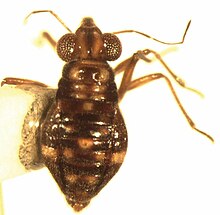Hip water sandpiper
| Hip water sandpiper | ||||||||||
|---|---|---|---|---|---|---|---|---|---|---|

|
||||||||||
| Systematics | ||||||||||
|
||||||||||
| Scientific name | ||||||||||
| Mesoveliidae | ||||||||||
| Douglas & Scott , 1867 |
The hip water striders (Mesoveliidae) or dwarf pond striders are a family of bedbugs within the suborder Gerromorpha that is widespread worldwide . There are almost 50 known species in 11 genera. There are 3 types in Europe.
features
The animals are 1.2 to 4.2 millimeters long and are very variable in their appearance and the development of their wings. Most species are greenish to brown in color and have long legs with an elongated, egg-shaped body. With Cryptovelia terrestris , the family includes one of the smallest species of bed bugs. Your compound eyes only consist of three to four individual ommatidia .
Her head is large and elongated and clearly extends beyond the compound eyes . The micro and macro hair is limited to the head and prosternum on the thorax . Pointed eyes ( ocelli ) are developed, but are absent in apter (wingless) adults. The antennae are four-part, the labium three-part. The maxillae are strongly toothed. The pronotum is truncated at the back. Winged individuals have a visible, enlarged, two-part label ( scutellum ). It is absent in wingless individuals. The olfactory gland openings on the metathorax are located on the metasternum (omphalium). The tarsi are tripartite, with the first segment being very small. The claws are apical. The front wings are built up evenly; the clavus and the membrane have a similar surface texture. The membrane lacks wing veins . The corium consists of two to three closed cells. The female ovipositor is well developed. It is toothed and fringed. The dorsal scent gland openings on the third to fourth tergum of the nymphs have receded. The Aedeagus has a specially shaped pump for ejaculation and a pear-shaped part. The parameters are symmetrical.
Occurrence
The family is spread around the world. The genus Mesovelia is widespread and includes a few species that have a very large range. All other species are limited to a limited range and show a rather scattered distribution overall. This and the basal position within the Gerromorpha suggest that the group is very old.
Way of life
The family prefers to settle in stagnant water, especially the banks of the water or the surroundings of plants or objects floating in the water. But there are also species that live on soaked moss and water-wetted rocks, in caves or on damp slime molds. In addition, there are also species that have developed further and live terrestrially in the leaf litter away from the water.
The bugs feed predatory or as scavengers; not infrequently from dead or injured animals on the water surface. They suckle on arthropods , including shellfish and mosquito larvae and pupae . The females pierce their eggs into the tissue of aquatic plants. A female can lay more than 100 eggs. The eggs overwinter in very cold areas. Active adults can be found all year round in warmer conditions. The animals are very nimble on the open water surface, mostly hanging around plants and having a rather hidden way of life.
Taxonomy and systematics
The family is the most primitive of the Gerromorpha suborder . It was historically placed in the vicinity of the sickle bugs (Nabidae) and predatory bugs (Reduviidae) and classified by Sahlberg in 1920 within the suborder Gerromorpha.
The following subfamilies are counted as part of the family:
- Subfamily Mesoveliinae
- Genus Austrovelia (2 species; Australia, New Caledonia)
- Genus Cavaticovelia (1 species; Hawaii)
- Genus Cryptovelia (1 species; Lower Amazon Basin)
- Genus Darwinivelia (2 species; South America, Galapagos Islands)
- Genus Mesovelia (approx. 25 species; worldwide)
- Genus Mniovelia (1 species; New Zealand)
- Genus Nereivelia (1 species; Singapore, Thailand)
- Genus Phrynovelia (3 species, New Guinea, New Caledonia)
- Genus Speovelia (2 species; Mexico, Japan)
- Madeoveliinae subfamily
- Genus Mesoveloidea (2 species; tropical America)
- Genus Madeovelia (1 species, Guinea)
The following types occur in Europe; Mesovelia furcata also in Central Europe.
- Mesovelia furcata Mulsant & Rey, 1852
- Mesovelia thermalis Horvath, 1915
- Mesovelia vittigera Horvath, 1895
supporting documents
Individual evidence
- ↑ a b c d e f g h R. T. Schuh, JA Slater: True Bugs of the World (Hemiptera: Heteroptera). Classification and Natural History. Cornell University Press, Ithaca, New York, 1995, pp. 88 ff.
- ↑ a b Mesoveliidae. Fauna Europaea, accessed December 21, 2013 .
- ↑ a b c d e Family Mesoveliidae. Australian Biological Resources Study. Australian Faunal Directory, accessed December 28, 2013 .
- ^ Ekkehard Wachmann , Albert Melber, Jürgen Deckert: Bugs. Volume 1: Cimicomorpha: Dipsocoromorpha, Nepomorpha, Gerromorpha, Leptopodomorpha, Cimicomorpha (part 1) (= The animal world of Germany and the adjacent sea parts according to their characteristics and according to their way of life . 77th part). Goecke & Evers, Keltern 2006, ISBN 3-931374-49-1 , p. 60 .
literature
- RT Schuh, JA Slater: True Bugs of the World (Hemiptera: Heteroptera). Classification and Natural History. Cornell University Press, Ithaca, New York, 1995.
- Ekkehard Wachmann , Albert Melber, Jürgen Deckert: Bugs. Volume 1: Cimicomorpha: Dipsocoromorpha, Nepomorpha, Gerromorpha, Leptopodomorpha, Cimicomorpha (part 1) (= The animal world of Germany and the adjacent sea parts according to their characteristics and according to their way of life . 77th part). Goecke & Evers, Keltern 2006, ISBN 3-931374-49-1 .
